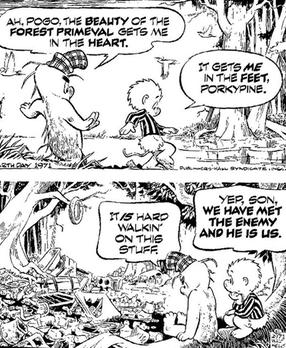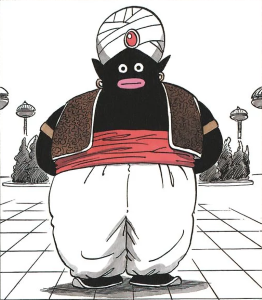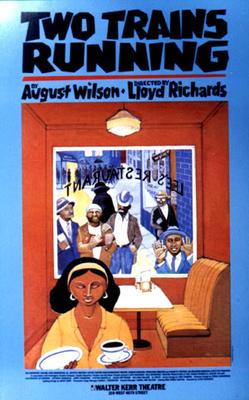A comic strip is a sequence of cartoons, arranged in interrelated panels to display brief humor or form a narrative, often serialized, with text in balloons and captions. Traditionally, throughout the 20th and into the 21st century, these have been published in newspapers and magazines, with daily horizontal strips printed in black-and-white in newspapers, while Sunday papers offered longer sequences in special color comics sections. With the advent of the internet, online comic strips began to appear as webcomics.

Pogo was a daily comic strip that was created by cartoonist Walt Kelly and syndicated to American newspapers from 1948 until 1975. Set in the Okefenokee Swamp in the Southeastern United States, Pogo followed the adventures of its anthropomorphic animal characters, including the title character, an opossum. The strip was written for both children and adults, with layers of social and political satire targeted to the latter. Pogo was distributed by the Post-Hall Syndicate. The strip earned Kelly a Reuben Award in 1951.

The Commercial Appeal is a daily newspaper of Memphis, Tennessee, and its surrounding metropolitan area. It is owned by the Gannett Company; its former owner, the E. W. Scripps Company, also owned the former afternoon paper, the Memphis Press-Scimitar, which it folded in 1983. The 2016 purchase by Gannett of Journal Media Group effectively gave it control of the two major papers in western and central Tennessee, uniting the Commercial Appeal with Nashville's The Tennessean.

Barney Google and Snuffy Smith, originally Take Barney Google, for Instance, is an American comic strip created by cartoonist Billy DeBeck. Since its debut on June 17, 1919, the strip has gained a large international readership, appearing in 900 newspapers in 21 countries. The initial appeal of the strip led to its adaptation to film, animation, popular song, and television. It added several terms and phrases to the English language and inspired the 1923 hit tune "Barney Google " with lyrics by Billy Rose, as well as the 1923 record "Come On, Spark Plug!"

Mr. Popo is a fictional character from the Dragon Ball manga series created by Akira Toriyama. Within the series, he is a genie who serves as the assistant to Earth's guardian deity and the caretaker of their residence, which is located high above the sky. He first appears in the one hundred sixty-third chapter of the Dragon Ball manga, published in 1988. In the Japanese anime adaptations, his voice actor was Toku Nishio, before Kawazu Yasuhiko took over the role for Dragon Ball Kai. For English language media, he was voiced by Christopher Cason in 1999 and from 2010 on. The character was also voiced by Chris Sabat from 2000 up until 2005.

The National Civil Rights Museum is a complex of museums and historic buildings in Memphis, Tennessee; its exhibits trace the history of the civil rights movement in the United States from the 17th century to the present. The museum is built around the former Lorraine Motel, which was the site of the 1968 assassination of Martin Luther King Jr. Two other buildings and their adjacent property, also connected with the King assassination, have been acquired as part of the museum complex.
Tiger was an American comic strip created by cartoonist Bud Blake. It ran from May 3, 1965 until 2004.

Sunday Go to Meetin' Time is a 1936 Warner Bros. Merrie Melodies cartoon directed by Friz Freleng. The short was released on August 8, 1936. The name of the short comes from the colloquial adjective "sunday-go-to-meeting", describing something appropriate for church or otherwise presentable.

Two Trains Running is a 1990 play by American playwright August Wilson, the seventh in his ten-part series The Pittsburgh Cycle. The play takes place in 1968 in the Hill District, an African-American neighborhood in Pittsburgh, Pennsylvania. It explores the social and psychological manifestations of changing attitudes toward race from the perspective of its urban Black characters. The play premiered on Broadway in 1992 and was a finalist for the Pulitzer Prize for Drama.

A lawn jockey is a statue depicting a man in jockey clothes, intended to be placed in front yards as hitching posts, similar to those of footmen bearing lanterns near entrances and gnomes in gardens. The lawn ornament, popular in certain parts of the United States and Canada in years past, was a cast replica, usually about half-scale or smaller, generally of a man dressed in jockey's clothing and holding up one hand as though taking the reins of a horse. The hand sometimes carries a metal ring and, in some cases, a lantern, which may or may not be operational.
Broom-Hilda is an American newspaper comic strip created by cartoonist Russell Myers. Distributed by Tribune Content Agency, it depicts the misadventures of a man-crazy, cigar-smoking, beer-guzzling, 1,500-year-old witch and her motley crew of friends.

Luther Andrews Dickinson is the lead guitarist and vocalist for the North Mississippi Allstars and the son of record producer Jim Dickinson. He is also known for being a guitarist for The Black Crowes. He hosts Guitar Xpress on the Video on Demand network Mag Rack.

The Memphis sanitation strike began on February 12, 1968, in response to the deaths of sanitation workers Echol Cole and Robert Walker. The deaths served as a breaking point for more than 1,300 African American men from the Memphis Department of Public Works as they demanded higher wages, time and a half overtime, dues check-off, safety measures, and pay for the rainy days when they were told to go home.
Robert Bartow Lubbers was an American comic strip and comic book artist best known for his work on such strips as Tarzan, Li'l Abner and Long Sam.

Calvin Lane Alley was the editorial cartoonist for The Commercial Appeal in Memphis, Tennessee, from 1945 until 1970.
The Bell Syndicate, launched in 1916 by editor-publisher John Neville Wheeler, was an American syndicate that distributed columns, fiction, feature articles and comic strips to newspapers for decades. It was located in New York City at 247 West 43rd Street and later at 229 West 43rd Street. It also reprinted comic strips in book form.

Talented 10th is the third studio album by American Christian hip hop artist Sho Baraka, released through his own label, Lions & Liars Music, on January 15, 2013. It is the first solo release by Sho Baraka since he left Reach Records in 2011. The album title and concept was based on the 1903 essay of the same name by W. E. B. Du Bois. Talented 10th is "not just a picture of Christian salvation but also focuses on education, relationships and social change - all filtered through a biblical worldview." However, Talented 10th was controversial with some in the Christian scene due to the appearance of strong language on the song "Chapter 9 - Jim Crow".

Ching Chow is an American one-panel cartoon that was created by Sidney Smith and Stanley Link. It first appeared on January 17, 1927, and ran for more than 60 years, under a variety of different creators. It was distributed by the Chicago Tribune / New York Daily News Syndicate. The title character was a stereotypical Chinese man with slanty eyes and a big, toothy grin. He offered pearls of Confucius-style wisdom, like "Beware of silent dog and still water."
J.P. Alley (1885–1934) was an editorial cartoonist whose work attacking the Ku Klux Klan brought his employer, the Memphis Commercial Appeal newspaper, the 1923 Pulitzer Prize for Public Service. He was best known for his Hambone's Meditations, a syndicated comic strip featuring a racist, Jim Crow caricature of an African American man.













